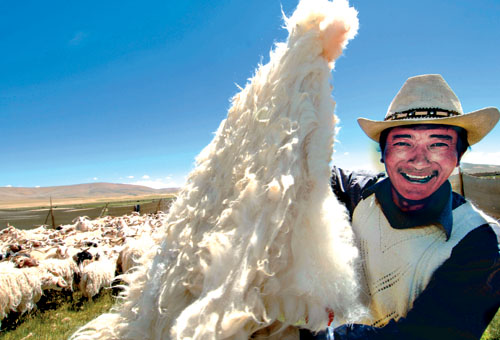|
In 2007, 44 characteristic industrial projects of agriculture and animal husbandry in the construction plan of Tibet were put into operation, covering seven prefectures (cities) and 50 counties (cities and regions), with a total investment of some 360 million Yuan. State investment covered 61.07 percent of the funding, and this was supplemented by the devoted labor of individuals and businesses. Through this, Tibet will create a number of major enterprises of agriculture and animal husbandry and famous brands of characteristic agricultural and livestock products, further improving the comprehensive productive capacity and market competitive power of agriculture and animal husbandry.
Animal Husbandry
 A happy Tibetan herder
A happy Tibetan herder
Tibet abounds in animal husbandry resources, boasting not only a variety of grassland, but also the plains, farmland and suburbs. The industrial belt of breeding Cashmere goat, yak, Tibetan sheep, pig and chicken and milch cow will become a major part in the development of animal husbandry of Tibet, providing more green products and greatly benefitting farmers and herders. In 2007, Tibet set great store by supporting the 71 characteristic agricultural and animal husbandry bases including the forage grass-bred milk cow base and effectively controlled the epidemic situation such as bird flu and rodent depredations. Animal husbandry maintained stable development, with the rate of domestic animals for sale being further increased. At the end of 2007, Tibet had 24.17 million head of domestic animals in stock, a fall of 210,000 head over the previous year. They included 6.61 million cows (an increase of 100,000), and 16.75 million sheep (a fall of 280,000). The output of pork, beef and mutton reached 228,800 tons, an increase of 0.8 percent and that of milk 289,400 tons, an increase of 4.8 percent.
Forestry
In 2007, the TAR planted 19,070 hectares of trees. This included 2,810 hectares of timber forest, 1,590 hectares of economic forest and 13,130 hectares of protection forest. The subsidization project for forest ecological benefit in Tibet proceeded smoothly. A total sum of 160 million Yuan was actually subsidized for protecting 2.17788 million hectares of forest.
In 2007, the project of forestation in key areas in Tibet made a good start. The project was planned to continue five years, with a total forested area of 48,000 hectares and total investment of 590 million Yuan. In 2007, the first year of the implementation of the project, Tibet planted 7333.33 hectares of trees. The people's government and forestry bureau of the TAR signed the Target Responsibility Document on Forestation during the period of the 11th Five-Year Plan with various places in the region, clearly formulating the task and responsibility. According to checks, the average survival rate of forestation was above 80 percent.
(China's Tibet Facts and Figures 2008) |
